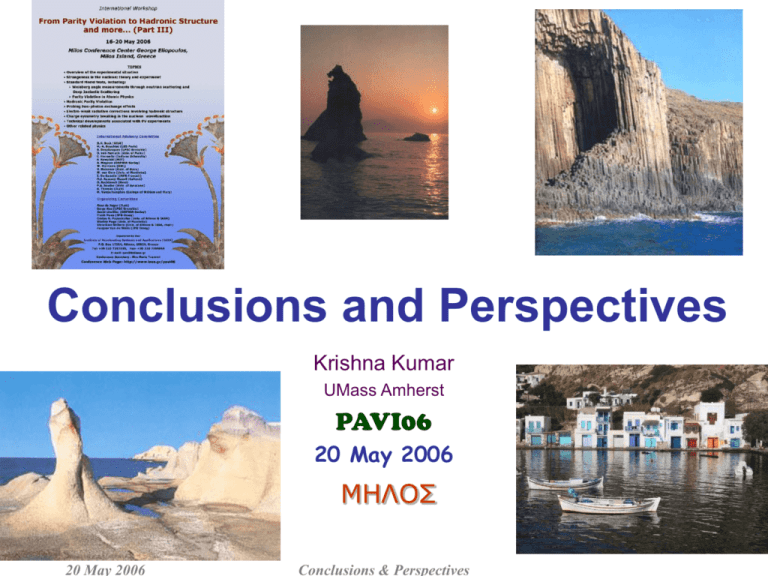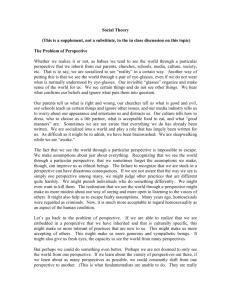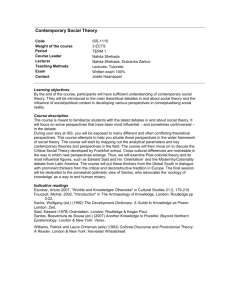ppt - IASA
advertisement

Conclusions and Perspectives Krishna Kumar UMass Amherst PAVI06 20 May 2006 ΜΗΛΟΣ 20 May 2006 Conclusions & Perspectives Acknowledgements Pictures, thoughts and ideas from: B. Holstein, K. Paschke, M.J. Ramsey-Musolf, P. Souder, M. Vanderhaeghen and all the speakers • Many thanks for the invitation: – K. De Jager, S. Kox, D. Lhuillier, F. Maas, S. Page, C. Papanicolas, S. Stiliaris • Ideal workshop setting: – Great location, organization and staff • Excellent Scientific Program: – Many exciting and interconnected subfields 20 May 2006 Conclusions & Perspectives Come On! Disclaimer I am a dumb experimentalist: The following is a personal view of the status of the field and its immediate future. I apologize in advance for any omissions • Many thanks for the invitation: – Thanks for a sleepless week! • Ideal workshop setting: – How are you supposed to get anything done?! – Didn’t you know this island has good ouzo?! • Excellent Scientific Program: – Hey, I did’nt know it was going to be this broad when I accepted! You tricked me!!! • But I learned a lot…. 20 May 2006 Conclusions & Perspectives Neutral Weak Interactions • The 50’s – Yang-Mills Theory – Zel’dovich and parity violation • The 60’s – Weinberg and SU(2)L X U(1)Y Theory: the Z boson • The 70’s – Neutrino electron scattering – Prescott and Weak Electromagnetic Interference • The 80’s – – – – Observation of W and Z bosons Atomic Parity Violation High statistics parity violating electron scattering Beginning of the LEP/SLC era: Z factories Low Energy WNC Interactions address a whole range of physics topics: since the 90s, it has become a precision tool 20 May 2006 Conclusions & Perspectives WNC Interconnections Electroweak Physics Valence Quark Physics Atomic Physics Nucleon Physics 20 May 2006 Nuclear Physics Conclusions & Perspectives The Beginnings • Gargamelle: neutrino scattering – First weak neutral current observation – Became centerpiece of electroweak theory Gargamelle found one e- event in 1973! (two more by 1976) • SLAC E122: Parity-violating Electron Scattering – Central to establishing SU(2)LXU(1)Y – Established the experimental technique Parity is violated 20 May 2006 Parity is conserved Conclusions & Perspectives 10 billion events! Weak Neutral Currents and the Atom 20 May 2006 Conclusions & Perspectives Atomic Parity Violation Boulder Experiment Power build-up cavity ( F=100 000 ) E xp Bp polarizes the atoms |F,m=±F> dye laser beam depletes one HF level B xex Reexcitation of the depleted HF levell diode laser, tuned to the depleted HF level I Ecole Normale Supérieure, Paris fluo APV signal: odd in E, xex, B, Bp, xp Derevianko, Lintz, Gwinner, Chardonnet, Budker, Sanguinetti, Tsigutkin Tremendous interest in weak charge, anapole moment and EDM measurements in the larger physics community 20 May 2006 Conclusions & Perspectives Atomic Parity Violation Electric and magnetic fields define handedness Photo-multiplier tubes Rotational Invariant: B Oven Collimator Ytterbium atoms E B Budker, Tsigutkin Light guide PBC mirror y z E ε B x Parabolic reflector 649-nm light Magnetic field coils 408-nm light Electric field plates Berkeley Yb Apparatus Anapole Moment We also heard from: •A. Derevianko with a nice theoretical overview •C. Chardonnet with an update on the search for parity violation in molecules •G. Gwinner with an update on Francium APV and anapole moment measurement preparations •S. Sanguinetti on the TRAP-RAD experiment to trap Francium Two comments: •It would be interesting to see another nonzero anapole moment, though connections to N-N interaction seem challenging •Is it worth doing the isotope measurements to access the neutron radius by assuming the Standard Model? There is tremendous interest in obtaining more information. 20 May 2006 Conclusions & Perspectives Weak Neutral Currents and the Nucleus 20 May 2006 Conclusions & Perspectives Hadronic PV EFT LANSCE, SNS Done p) mN pp 1.22 AL (p Short Range Medium Range Long Range Ramsey-Musolf, Holstein, Schiavella, Desplanques, Hyun mN t 9.35 AL (np d ) HARD* mN pn 1.6 AL (pp) 3.7 AL (p ) 37 A (np d ) 2 P (np d ) mN t 0.4 AL (pp) 0.7 AL (p ) 7 A (np d ) P (np d ) d n mN nn 1.6 AL (pp) 0.7 AL (p ) 33.3 A (np d ) 1.08 P (np d ) 0.83 dz Pionless th’y: 5 exp’ts Dynamical pions: 7 exp’ts 20 May 2006 NIST,SNS Ab initio few-body calculation required Conclusions & Perspectives Hadronic PV Experiments Transverse Polarization N-4He Spin Rotation Experiment y Bowman, Snow Medium with Parity Violation z φ Helicity Components Optical Rotation We also heard about the npd at LANSCE New versions of these experiments will be launched at the Spallation Neutrion Source Theoretical developments and the SNS have allowed these experiments to gather new momentum 20 May 2006 Conclusions & Perspectives Probing Neutron-Rich Matter Piekerewicz, Michaels Constrain neutron halo for APV Constrain neutron star crust thickness QpEM ~ 1 QnW ~ 1 QnEM ~ 0 QpW ~ 1 - 4sin2W 20 May 2006 Conclusions & Perspectives PREx at Jefferson Lab (APV) ~ 3% (Rp-Rn) ~ 1% Piekerewicz, Michaels Q2 ~ 0.01 GeV2 APV ~ 0.5 ppm A technically demanding measurement: •Rate ~ 2 GHz •Separate excited state at 2.6 MeV •Stat. Error ~ 15 ppb •Syst. Error ~ 1 to 2 % 208 Data collection at JLab Hall A likely in 2008 Pb 12 beam C •Tight control of beam properties •New “warm” septum •New 18-bit ADC •New radiation-hard detector •Polarimetry upgrade Diamond Backing: • High Thermal Conductivity • Negligible Systematics 20 May 2006 Conclusions & Perspectives Weak Neutral Currents and the Nucleon 20 May 2006 Conclusions & Perspectives Nucleon Structure & Strangeness Schaefer, Leader, Procureur QCD is intractable at low Q2; what is its relationship to hadron structure? Why don’t sea quarks destroy Quark Model predictions? Strange quarks are relatively light What can we say about its role? Neutrino deep inelastic scattering s ~ N s 5s N Breaking of SU(3) flavor symmetry introduces uncertainties Semi-inclusive: s = 0.03 ± 0.03 fragmentation function 20 May 2006 Conclusions & Perspectives N scattering: Strange mass: 0-20% Elastic Electroweak Scattering Armstrong, Real, Baunack, Kox, Glaeser, Moffit Kaplan & Manohar (1988) McKeown (1990) GEs(Q2), GMs(Q2) Helium: Unique GE sensitivity Deuterium: Enhanced GA sensitivity GF Q 2 AE AM AA ~ few parts per million A p 4 2 proton: AE GEp GEZ , AM GMp GMZ , Forward angle 20 May 2006 AA 1 4 sin 2 W 'GMp G Ae Backward angle Conclusions & Perspectives Overview of Experiments Armstrong, Real, Baunack, Kox, Glaeser, Moffit A4 SAMPLE Open geometry open geometry, integrating GM HAPPEX s, (GA) at Q2 = 0.1 GeV2 Fast counting calorimeter for background rejection GEs + 0.23 GMs at Q2 = 0.23 GeV2 GEs + 0.10 GMs at Q2 = 0.1 GeV2 GMs, GAe at Q2 = 0.1, 0.23, 0.5 GeV2 GEs + 0.39 GMs at Q2 = 0.48 GeV2 Superconducting Coils GEs + 0.08 GMs at Q2 = 0.1 GeV2 GE s at Q2 = 0.1 GeV2 G0 (4He) Particle Detectors Electron Beam Open geometry LH2 Target Fast counting with magnetic spectrometer + TOF for background rejection GEs + h GMs over Q2 = [0.12,1.0] GeV2 GMs, GAe at Q2 = 0.23, 0.62 GeV2 20 May 2006 Conclusions & Perspectives Current Status Over the past two years: New data from A4, G0 and HAPPEX Q2 ~ 0.1 GeV2 •Forward angle data nearly finished •One high precision point at Q2~0.6 •Await backward angle measurements from A4, G0 •Deuterium running will provide constraints on GA 20 May 2006 Conclusions & Perspectives Strangeness Theory Strangeness in the nucleon has challenged model builders for two decades • Quark Model (Riska) – While the ss-bar component is very compact, specific 5 quark states (with s-bar in the ground state) leads to positive GMs • Chiral Quark Soliton Model (Goeke) – Interesting Q2 dependence will be tested soon! • Heavy Quark Contribution (Toublan) – Raises the issue of the sign of the disconnected light and heavy quark loops • VMD Approach (Bijker, Dubnicka) – Some sensitivity to the assumed asymptotic behaviour of the strange form factors • Lattice Gauge Theoretic Approach (Zanotti, Young) – Nice way to access sea quark dynamics, but a critical component involves a hadronic model without consensus on the assigned error 20 May 2006 Conclusions & Perspectives Axial Form Factor Bodek, Schindler •Neutrino oscillations experiments need accurate cross-sections •Discrepancy between neutrino and electroproduction data understood •PV experiments need Q2 dependence for backward angle measurements Minerva will make accurate measurements 20 May 2006 Conclusions & Perspectives Charge Symmetry Breaking Lewis Chiral perturbation theory with resonance saturation 20 May 2006 Conclusions & Perspectives Nucleon EM Form Factors Alarcon, Pacetti, Dubnicka BLAST at MIT-Bates Low Q2 data critical to reduce systematic error in extraction of Gs 20 May 2006 Conclusions & Perspectives Personal Outlook • • • • Forward Angle – Fast variation in the range 0<Q2<0.3 GeV2 ruled out by latest HAPPEX data – Still a window to see non-zero strangeness at Q2~0.6 GeV2 – Charge symmetry, radiative corrections and EM form factor uncertainties preclude any further precision at any Q2 Backward Angle – New G0 and A4 data sensitive to cancellations at intermediate Q2 – Knowledge of GA and background asymmetries will limit further precision than already proposed Theory – Models are challenged in dealing with properties purely of the sea – Ultimate insight must come from unquenched lattice calculations with light chiral quarks Where are we? – We have answered a 20 year-old question about nucleon structure: do strange quark contribute to the charge and magnetization distributions of nucleons? The answer seems to be: smaller than expected but we have to complete the approved program. Beyond that, it is in the realm of lattice QCD. 20 May 2006 Conclusions & Perspectives Beam-Normal Asymmetries beam : Vanderhaeghen, Pasquini, Kaufman, Capozza ' ' •Imaginary part of two-photon exchange amplitude •“background” for parity-violation experiments A4 Preliminary at 300 MeV 20 May 2006 Conclusions & Perspectives Beam-Normal Asymmetries at JLab Kaufman, Vanderhaeghen First measurement on a nucleus HAPPEX Hydrogen target HAPPEX 11 GeV beam at different Q2 values 20 May 2006 Conclusions & Perspectives Gluon Polarization Leader, Proceureur lepton beam proton beam or or 0, (PHENIX), jets (STAR) or heavy flavor, high pT or nucleon target proton beam STAR •Strangeness and gluon polarization are the only two “purely sea” experimentally accessible observables •RHIC and lepton DIS experiments both agree G is small •They will make inroads, but the ultimate measurements will require a lepton-ion collider: obtain G directly and by DGLAP evolution of g1 20 May 2006 Conclusions & Perspectives Weak Neutral Currents and the Valence Quark 20 May 2006 Conclusions & Perspectives NuTeV Anomaly Londergan 3σ below SM agree with SM After ~ three years, no consensus yet No “good” new physics scenario Assumptions: • Isoscalar target (N=Z) • include only light (u, d) quarks • neglect heavy quark masses • assume isospin symmetry for PDFs • no nuclear effects (parton shadowing, EMC, ….) • no contributions outside Standard Model Community Prejudice: some combination of isospin violation, nuclear effects, strangeness asymmetry and systematics on radiative corrections 20 May 2006 Conclusions & Perspectives PV DIS Reimer, Souder, Zheng Address outstanding issues in high x physics APV GF Q2 a(x) f (y)b(x) 2 C Q f (x) a(x) Q f (x) 1i C1i 2g g e i A V C2i 2g g e V i A i i i 2 i i C Q f (x) b(x) Q f (x) i • Charge Symmetry Violation – Partonic level CSV has never been observed high precision with inclusive scattering – Needs • d(x)/u(x) at as x 1 – Longstanding QCD prediction – Needs high precision without nuclear effects • Higher Twist – Absence of significant higher twist a surprise – Needs high precision on “predictable” reaction 20 May 2006 Conclusions & Perspectives 2i i i i 2 i i i PV DIS with JLab Upgrade Souder, Londergan Charge Symmetry Violation at High x: clean observation possible For an isoscalar target like 2H a(x) 3 (2C1u C1d ) 10 APV (x) APV (x) APV For hydrogen a(x) u(x) d(x) u(x) d(x) u(x) u p (x) d n (x) d(x) d p (x) u n (x) GF Q2 a(x) f (y)b(x) 2 u(x) 0.91d(x) u(x) 0.25d(x) Longstanding issue: d/u as x1 •Allows d/u measurement on a single proton! •Vector quark current! (electron is axial-vector) 20 May 2006 3 uv (x) dv (x) (2C C ) 2u 2d 10 u(x) d(x) Global fits allow x3 larger effects 1H: 0.3 b(x) Conclusions & Perspectives 1% APV measurements A Vision for PV DIS Physics Souder • • • • • • Hydrogen and Deuterium targets Better than 2% errors – It is unlikely that any effects are larger than 10% x-range 0.25-0.75 W2 well over 4 GeV2 Q2 range a factor of 2 for each x point – (Except x~0.75) Moderate running times •CW 90 µA at 11 GeV •40 cm liquid H2 and D2 targets •Luminosity > 1038/cm2/s •solid angle > 200 msr •Count at 100 kHz • online pion rejection of 102 to 103 Goal: Form a collaboration, start real design and simulations, and make pitch to US community at the next nuclear physics long range plan (2007) 20 May 2006 Conclusions & Perspectives Weak Neutral Currents and TeV Physics Beyond the Standard Model 20 May 2006 Conclusions & Perspectives Beyond Standard Model @ Low Q2 KK •Precise predictions @ 0.1% •Indirect access to TeV scale •World electroweak data has marginal 2, but no discernable pattern •Data used to put limits on energy scale of new physics effects •Parity-conserving contact interactions probed at 20-30 TeV level •Parity-violating contact interactions probed at 5-10 TeV level 20 May 2006 Conclusions & Perspectives SLAC E158 KK sin2eff = 0.2397 ± 0.0010 ± 0.0008 APV = (-131 ± 14 ± 10) x 10-9 * Limit on LLL ~ 7 or 16 TeV * Limit on SO(10) Z’ ~ 1.0 TeV * Limit on lepton flavor violating coupling ~ 0.01GF 20 May 2006 End of the SLAC Fixed Target Program Conclusions & Perspectives The LHC Erler • LHC to begin data collection in 2008 • Focus is on EW symmetry breaking – Standard Model Higgs hard below 150 GeV and above 500 GeV • Energy frontier: look for the unexpected – The unexpected at LHC likely to remain ill-defined! – The more obscure the signal, the more important are low energy constraints! • Electroweak Physics at the LHC – Factor of 3 improvement in W Mass – Factor of 5 improvement in Top Mass – Weak Mixing Angle: Improve constraints on new parity-conserving contact interactions 20 May 2006 Conclusions & Perspectives Qweak at JLab Region 1: GEM Gas Electron Multiplier Region 2: Horizontal drift chamber location Mini-torus Page Quartz Cerenkov Bars (insensitive to non-relativistic particles) e- beam MNC Lumi Monitors QTOR Magnet Collimator System Trigger Scintillator Region 3: Vertical Drift chambers •Design, simulation, prototyping, construction •Installation in 2009 •Complementary to LHC •Important constraint should LHC see anomaly 20 May 2006 Conclusions & Perspectives C1i’s measured to unprecedented precision Beyond SM with PV DIS Zheng, Reimer For an isoscalar target like 2H, structure functions largely cancel in the ratio: a(x) 3 (2C1u C1d ) 10 3 uv (x) dv (x) b(x) (2C2u C2d ) 10 u(x) d(x) (Q2 >> 1 GeV2 , W2 >> 4 GeV2, x ~ 0.3-0.5) Complementary to LHC •Need to characterize nucleon structure at high-x to high precision •6 GeV experiment launches PV DIS measurements at JLab •12 GeV experiment requires tight control of normalization errors •Important constraint should LHC see anomaly 20 May 2006 Conclusions & Perspectives Møller Scattering @ 12 GeV Mack •Comparable to single Z pole measurement: shed light on disagreement •Best low energy measurement until ILC or -Factory •Could be done ~ 2012-13 Z pole asymmetries Address longstanding discrepancy between hadronic and leptonic Z asymmetries 20 May 2006 Conclusions & Perspectives Ultrahigh Precision at ILC KK Measure contribution from scalars to oblique corrections t new H physics b Z mH mH 10% for sin 2 W 0.00004 Critical crosscheck ALR and MW at future colliders: Systematics extremely challenging! Energy scale to 10-4, polarimetry to 0.15% Møller scattering at the ILC • Fixed target has advantages for systematics • Could work with ILC “exhaust”beam 20 May 2006 (world average ~0.00016) E158 LC Energy (GeV) 48 250-500 Intensity/pulse 4.5 1011 14 1011 Pulse Rate (Hz) 120 120 Pe 85% 90% Time (s) 4 106 2 107 ALR (ppm) 0.15 1-2 ALR (ppm) 0.015 0.008 sin2(W) 0.001 0.00008 K.K, Snowmass 96 Conclusions & Perspectives Theoretical Challenges • Hadron Structure Theory (A. Schäfer) – – – – Era of precision QCD requires major effort Examples of NNLO convergence (e.g. DVCS) Lattice QCD should enter the realm of dynamical chiral quarks Balanced effort in perturbative QCD, chiral perturbation theory and Lattice QCD • Low Energy EW Measurements & Loops (W. Marciano) – Gamma-Z and Gamma-W boxes for semi-leptonic processes – Improved calculation of super-allowed beta decays – Future applications: APV, neutrino scattering… • Future Directions (M. Ramsey-Musolf) – Probing higher-twist effects in PVDIS: precision measurements with improved leading-twist predictions – EFT approach to few-body hadronic parity violation – SUSY implications of precision low energy EW measurements – CP and T violation probes via EDM with implications for dark matter and the primordial baryon asymmetry 20 May 2006 Conclusions & Perspectives Parity Violating Electron Scattering Experimental Challenges 20 May 2006 Conclusions & Perspectives Polarized Source Controls Aulenbacher, Pashke Lockin Sw. diode-laser PC micron Pulser 5*x’ Grand average: ~ 1 nm Movable Detektor with pinhole 4*ppm 4*E/E Grand average: ~ 0.25 ppb HAPPEX Position Differences during run with hydrogen target More and more demanding and ambitious with every run! 20 May 2006 Conclusions & Perspectives Cryogenic Targets E158 at SLAC G0 target at Jlab 20 May 2006 Requirements are becoming ever-demanding! Conclusions & Perspectives Hydrogen: 86.7% ± 2% Polarimetry Diefenbach, Mack Signal from A4 Compton Polarimeter HAPPEX Hydrogen Run •High future demands for sub-1% polarimetry: Critical to have redundancy •Promising techniques: “high-field” Moller and Atomic Hydrogen polarimetry 20 May 2006 Conclusions & Perspectives Where are we going? Electroweak Physics Valence Quark Physics Atomic Physics Nucleon Physics Nuclear Physics We will continue to learn a whole lot along the way 20 May 2006 Conclusions & Perspectives Personal Thoughts Studies of Weak Neutral Current Interactions touches on extraordinarily rich and diverse topics We learn to appreciate physics over all length scales and there is much left to learn over the full range What strikes me in these PAVI meetings is that the participants are not particle or nuclear or atomic physicists We are physicists I look forward to many more rewarding interactions with you at the next PAVI!!! 20 May 2006 Conclusions & Perspectives Not into the sunset! 20 May 2006 Conclusions & Perspectives





